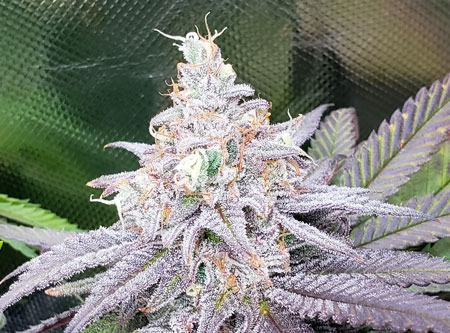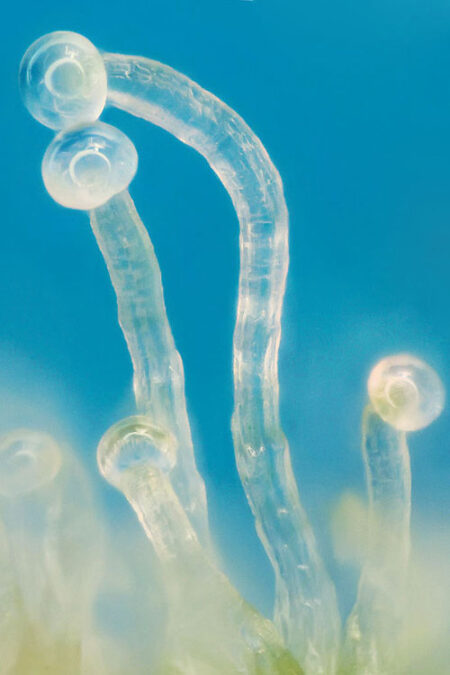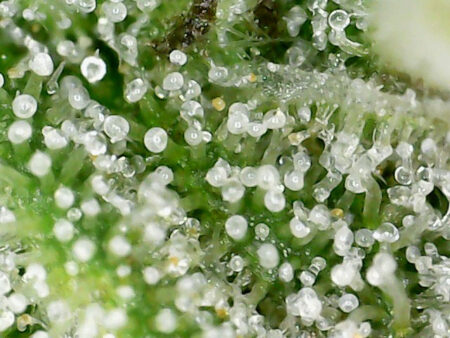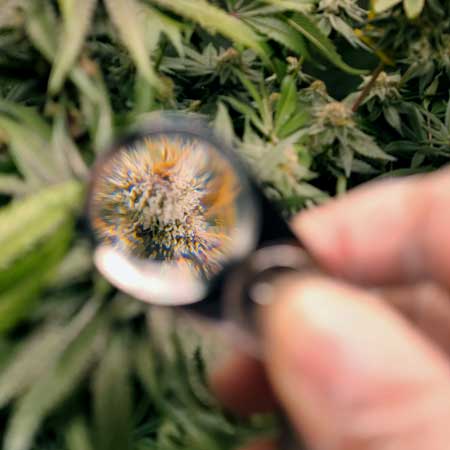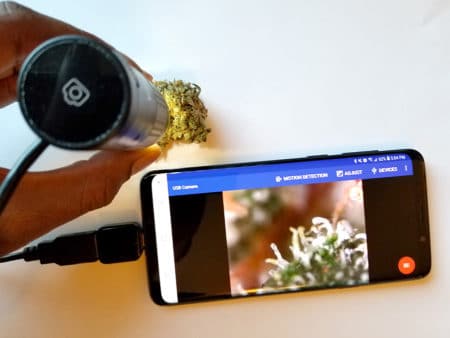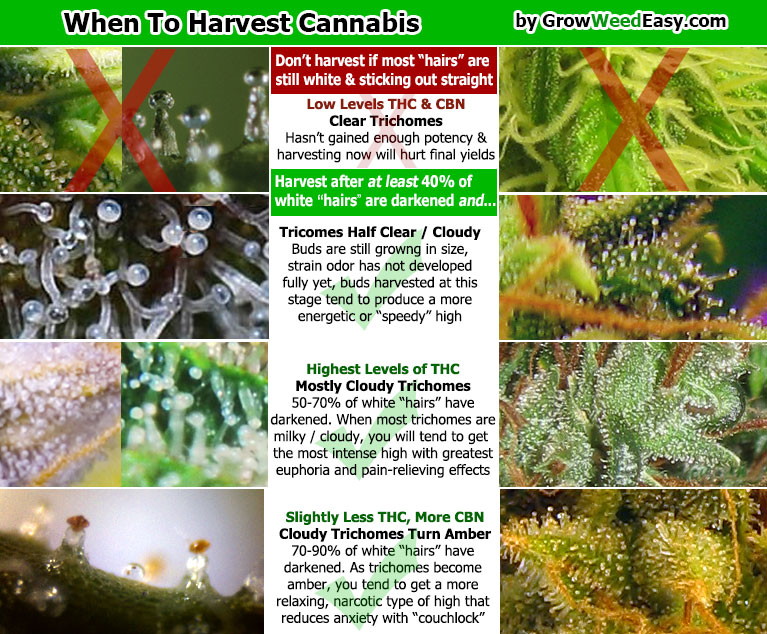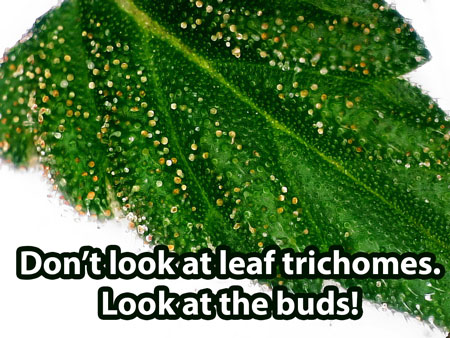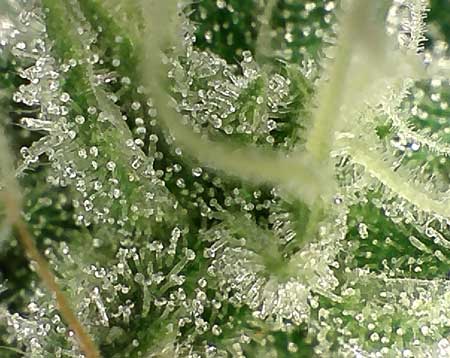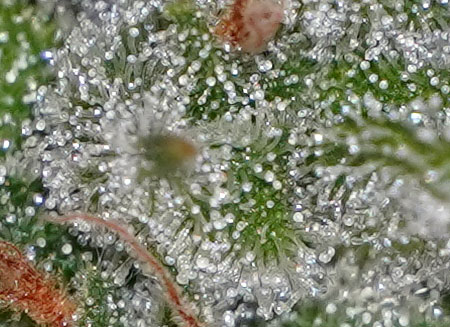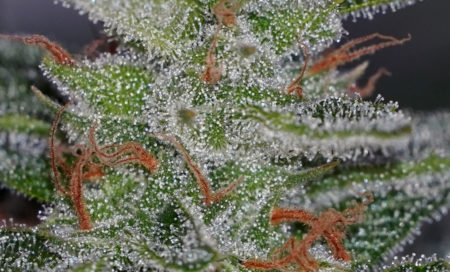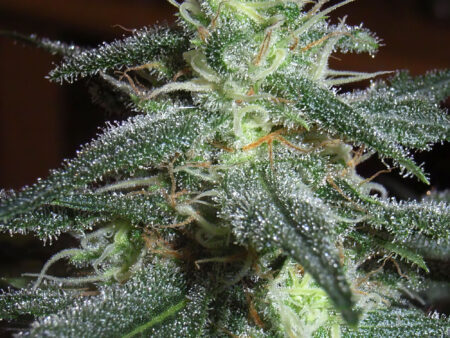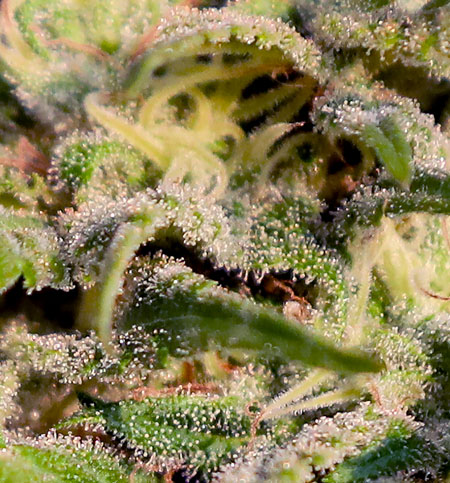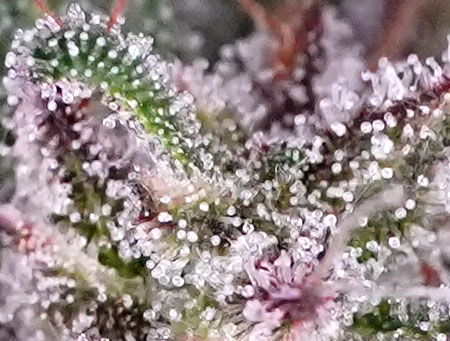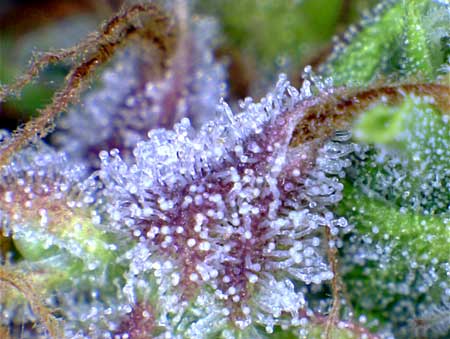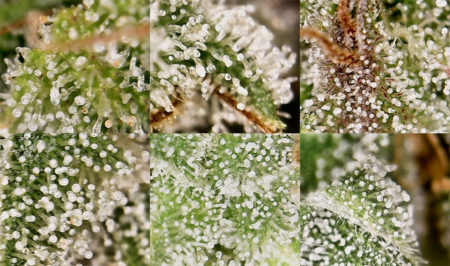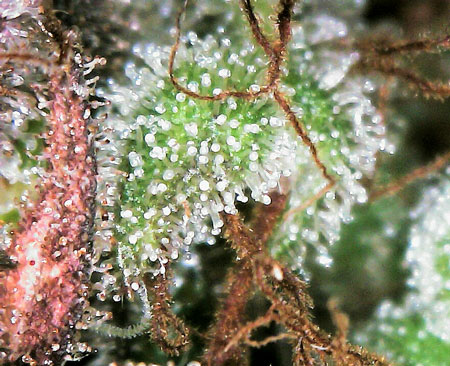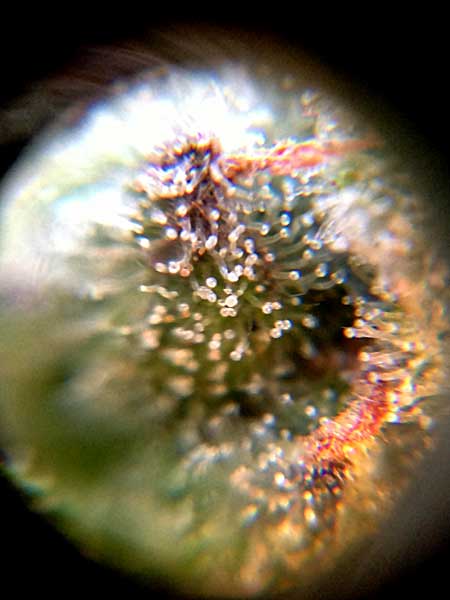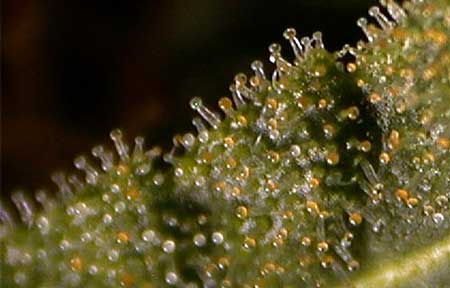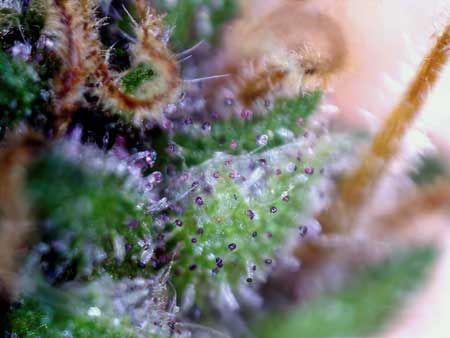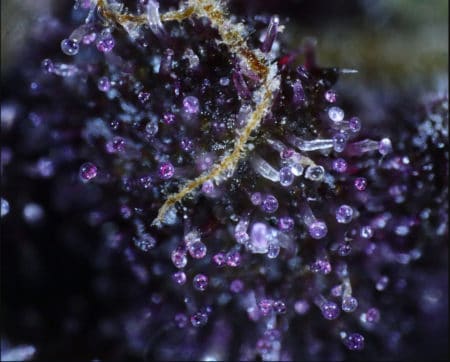by Nebula Haze
Welcome cannabis growers! Today’s tutorial is about an exciting topic: sparkly beautiful trichomes and trichome color at harvest. Did you know trichome color can be used to determine when to harvest your buds? Note: We have an article on how to look at trichomes under a magnifier as well as pictures of cannabis buds that are ready to harvest. I’ll cover both topics briefly here, but if you don’t have a magnifier yet, you might want to start with one of those.
The sparkly “glitter” on cannabis buds is made from structures known as trichomes.
Looking at trichomes under magnification tells you exactly when your cannabis plant is ready to harvest. Today’s tutorial will show you how!
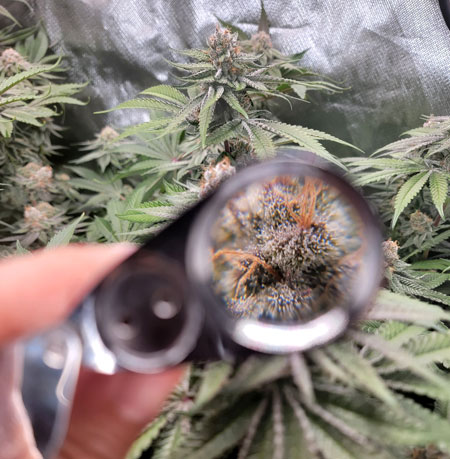
Why should growers look at cannabis trichomes under a microscope?
- Maximize THC – The color of trichomes helps tell you when the plant has reached peak THC and other cannabinoids like CBD.
- Maximize Yields – Looking at trichomes helps prevent harvesting too early, which is the number one way many growers needlessly hurt their yields and bud potency.
- Choose the Effects You Want – Harvest cannabis plants on the early side for more “in your head” and psychedelic effects, harvest on the later side for more “in your body” or physical effects. Looking at the trichomes lets you dial in on the perfect harvest time for the effects you want.
Looking at the color of trichomes helps tell you when buds have maximum THC and will produce the effects you want. As a bonus, harvesting at the right time tends to increase yields.
How do I look at trichomes under a magnifier?
Here are the most common ways to example marijuana trichomes under magnification to determine the best time to harvest your weed plants.
How to magnify trichomes so you can see them
- Jeweler’s loupe (cheap yet effective). A jeweler’s loupe is a small magnifier meant to look closely at jewelry. These are super cheap, easy to use, and effective. The only downside is they’re a bit hard to see through, especially if your eyes have a tough time focusing.
- USB microscope (see trichomes clearly) – USB microscopes can be hooked up to most smartphones so you can take videos or pictures through your phone. That makes it easy to see the trichomes closely without having to squint through a jeweler’s loupe.
- Smart phone (Depends on your model) – These days many smartphones have excellent cameras. Newer phones like iPhones and Samsung Galaxy phones can sometimes zoom in to take pictures of trichomes with their regular camera. Removing a bud and putting it on a table under a bright light can be ideal, and then you can dry that bud and “test” it for potency.
Read the full tutorial on different ways to magnify trichomes.
Tips for taking trichome pictures:
- Add as much natural light as you can
- Keep buds still because any movement makes the picture blurry when taking pictures of something that small
- Zoom in as far as you can
- Keep the camera still enough to see the trichomes. Sometimes it helps if you can set the camera on something so you don’t have to hold it up.
A jeweler’s loupe is the cheapest and most simple way to view trichomes
Probably the “best” way to check trichomes is to use a USB microscope. These let you take videos and pictures of the bud with your phone or laptop, so you can easily see the trichomes on the screen. It also lets you record the video so you can look at the trichomes more closely afterwards, which is surprisingly helpful when you had a hard time determining their color.
Sometimes you can take a picture with a smartphone that magnifies the trichomes. Make sure to have a lot of light and keep both the phone and bud as still as possible.
A jeweler’s loupe and a USB microscope are the two best magnifiers for checking cannabis trichomes in my experience, but what other magnifiers can you use?
- Check out the full article on how to look at trichomes under a magnifier – See how trichomes look through several different common magnifiers (from magnification glasses to microscopes and mroe)
Trichome Picture Gallery: Are these cannabis trichomes ready to harvest?
Here are a ton of pictures of cannabis trichomes to help you determine whether your marijuana plants are ready to harvest. These trichomes were magnified using either a jeweler’s loupe, or through a USB microscope. However, remember that different cannabis strains mature differently, and sometimes you’ll see trichomes that don’t look quite like these ones here.
Quick Guide to Trichomes
- Clear trichomes (Early) – trichomes start clear, almost like glass, and this shows they are not at full THC potential. Clear trichomes tend to produce more “speedy” or “psychedelic” effects.
- White/milky trichomes (Peak Potency) – strongest effects, highest THC, highest CBD. For most growers, it’s recommended to try to harvest when most trichomes are white.
- Amber/yellow/golden trichomes (Late) – THC is starting to degrade into the less-potent cannabinoid known as CBN, which is why amber trichomes often produce more of a “couchlock” or physical effect, but less strong mental effects
What about other colors on trichomes? Some cannabis strains produce trichomes in other colors like purple or pink. These trichomes may never turn white. When it comes to these “exotic” trichomes, the standard rules don’t always apply. In these cases, it’s best to ask the breeder when the trichomes indicate readiness. If that’s not possible, make sure to look at the buds and ensure they look ready from a visual inspection, and use the trichomes as only a secondary indicator.
Look at the trichomes on the buds, not the leaves! They often develop at different rates.
Not Ready to Harvest (Too Early)
At this point, most trichomes are clear, and less than half are white. This is too early to harvest
“Clear” trichomes look almost like they’re made of glass. The “heads” aren’t very fat yet. Not ready to harvest.
If you see mostly clear trichomes, it’s still too early to harvest. Wait a few more weeks.
Ready to Harvest
Here are pictures of cannabis trichomes that are ready to harvest.
Early Side – Half Clear, Half White
The harvest window is open when trichomes are half clear, half white. At this point, effects tend to be more psychedelic and “in your head” but overall potency is lower than if you waited for more trichomes to turn white.
Half Clear, Half White Trichomes – More speedy effects, lower yields, less of a body effect. You probably want to wait a bit longer.
Sometimes it’s hard to tell what color the trichomes are. For example, in this next picture, there are clear trichomes, white trichomes, and yellow/amber trichomes. That variety of trichome colors can happen as a result of stress or simply genetics (some strains just do that). So what do growers do when the trichomes are unclear? When in doubt, look at the hairs on the buds. If they’re still mostly white like the hairs in this picture, the bud isn’t ready. Most white hairs darken and curl in before buds are ready to harvest. Check out pictures of ready-to-harvest buds to be able to tell harvest time when the trichomes are confusing.
The trichomes are unclear in this picture, but the white hairs show that the bud is not ready to harvest. This bud still needs several more weeks to mature.
Peak Potency – Mostly White
These are mostly white, so you could harvest this if you wanted, though I still see a few clears here and there. That means you could probably wait another week or so.
Mostly White Trichomes with a few amber ones here and there – peak THC, peak CBD, typically the recommended time to harvest for most growers.
I think of the white trichomes as looking “milky” or kind of like white plastic. You can see one or two yellow trichomes here, which is a sign that you’re at peak potency. If you’re looking for high THC, you want to harvest before too many more turn amber.
Here’s an example of many different cannabis plants that are ready to harvest. Click for closeup!
Some strains never get many yellow trichomes, especially certain haze or sativa strains (long-flowering tall strains that originate from near the equator). This plant was flowering for over 3 months and just about all the trichomes were still white. However, the buds were starting to look unhealthy. if you look at the hairs in this magnified pictures, you can see they’re dark brown and withing. That’s another sign your buds are ready to harvest. If all the hairs look like they’re dying, it’s harvest time regardless of what the trichomes say!
Late Side – Many Tichomes are Turning Yellow/Amber
When you see amber trichomes, it means THC is starting to degrade to the sleeper, gentler, more “body high” cannabinoid known as CBN. Good for growers looking for strong body effects, but may feel like “potent” or psychedelic. Since it’s the latest harvest, you also tend to get the best yields (buds keep fattening right up until you harvest them).
These trichomes are mostly white but the grower is seeing more ambers every day. This is a great time to harvest to get a body high but still keep maximum potency.
These trichomes are half amber, but most of the rest are still clear. When it’s confusing what the trichomes are telling you, look at the buds themselves to know when to harvest. Buds are ready to harvest when they seem solid and most white hairs have darkened and curled in. Sometimes the trichomes just aren’t very helpful.
I see several amber trichomes on this bud, and also the hairs are dark brown and curled in. Harvest time!
What about other colors?
Some cannabis strains produce trichomes in other colors like purple or pink. These trichomes may never turn white. When it comes to these “exotic” trichomes, the standard rules don’t always apply. In these cases, it’s best to ask the breeder when the trichomes indicate readiness. If that’s not possible, make sure to look at the buds and ensure they look ready from a visual inspection and use the trichomes as only a secondary indicator.
These trichomes started white as normal and then just turned purple instead of amber.
But for some strains, the trichomes turn purple from the beginning and therefore the color doesn’t tell you anything about potency. That’s why with colorful trichomes it can be best to either ask the breeder about when to harvest look at the buds themselves to determine when to harvest.
Conclusion
Cannabis growers should look at buds, but the best way to determine the ideal harvest window is to also look at the sparkly trichomes under magnification to determine their color. While the appearance of buds gives a good overall indicator of maturity, the trichome color reveals extra details about potency and effects. Since you can buy a jeweler’s loupe for $10 or even just take magnified pictures of trichomes on your smartphone, I highly recommend paying at least a little attention to trichome development to maximize THC and CBD levels and avoid harvesting too early.
For most strains, clear trichomes mean the bud needs more time to mature, white trichomes show peak potency and greatest THC, while amber trichomes signify THC levels are dropping and can cause more of a sleepy/body effect. However, some strains produce exotic trichome colors or go through a different maturation process, in which case the best option is often to revert back to looking at the appearance of the buds. Some strains don’t make all three colors of trichomes (for example they may go from clear to amber, or never make any ambers). In these cases, check with the breeder or rely more heavily on bud appearance.
When checking trichomes, look only at trichomes on the buds, not the leaves. A jeweler’s loupe offers a simple solution, but a USB microscope makes viewing easier and allows you to capture images. Now that you know how to read those sparkly trichomes, be sure to also review the articles below to further improve quality and maximize your harvest.
Good luck and happy harvesting! May your buds be frosted with trichomes and your yield be blessed. The fruits of your labor await!
You may enjoy some of the following articles:
- When to harvest buds (full tutorial)
- Pictures gallery of ready-to-harvest cannabis buds
- Drying and curing tutorial
- Does a 3-day dark period increase bud potency?
- What to do if buds are taking too long to mature?
About the Author Nebula Haze
My name is Nebula Haze and I have been growing cannabis in the home environment since 2008. I’ve made every mistake but also learned every trick and technique to produce the absolute best bud quality and yields in the home environment without having to spend an arm and a leg. If you enjoyed today’s article, please sign up for our weekly newsletter and get a new growing article delivered to your email inbox every Sunday morning.
Happy Growing! ~Nebula Haze, co-founder of GrowWeedEasy.com

